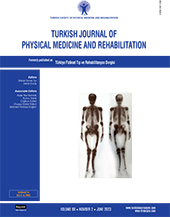The relationship of multifidus and gastrocnemius muscle thickness with postural stability in patients with ankylosing spondylitis
2 Department of Physical Medicine and Rehabilitation, Haydarpaşa Numune Training and Research Hospital, Istanbul, Türkiye DOI : 10.5606/tftrd.2023.11990 Objectives: This study aimed to investigate potential changes in the thickness of the multifidus and gastrocnemius muscles and to demonstrate the association of muscle thickness with postural stability in ankylosing spondylitis (AS) patients.
Patients and methods: The cross-sectional observational study enrolled 32 AS patients (23 males, 9 females; mean age: 39.4±7.2 years; range, 18 to 65 years) diagnosed according to the modified New York criteria and 32 healthy controls (22 males, 10 females; mean age: 36.6±7.5 years; range, 18 to 65 years) between April 2017 and October 2018. Plantar center of pressure (CoP) excursions were recorded using a pressure platform to evaluate postural stability. The thickness of the lumbar multifidus and gastrocnemius muscles was measured using ultrasound.
Results: Patients with AS showed reduced muscle thickness at the multifidus (p<0.05) muscle and medial gastrocnemius (p=0.002) and lateral gastrocnemius (p=0.002) muscles compared to controls. Increased CoP excursions were observed only in the anteroposterior direction in the double-leg (standard) stance with the eyes closed (p=0.003) and in both anteroposterior and mediolateral directions in tandem and single-leg stances (all p<0.05). Center of pressure excursions in standard stance with the eyes closed were negatively correlated with all muscle thickness values (all p<0.05). In the single-leg stance, CoP excursions were negatively correlated with muscle thickness of medial gastrocnemius (p=0.008) and lateral G (p=0.016) muscles.
Conclusion: Early planning of exercise programs taking muscle loss into account can help improve balance and thereby prevent falls and fractures in AS patients.
Keywords : Ankylosing spondylitis, multifidus, postural balance, ultrasonography

















